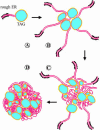Endoplasmic reticulum, oleosins, and oils in seeds and tapetum cells
- PMID: 15542496
- PMCID: PMC527141
- DOI: 10.1104/pp.104.051060
Endoplasmic reticulum, oleosins, and oils in seeds and tapetum cells
Figures


Similar articles
-
ER-derived compartments are formed by highly regulated processes and have special functions in plants.Plant Physiol. 2004 Nov;136(3):3411-3. doi: 10.1104/pp.104.900125. Plant Physiol. 2004. PMID: 15542493 Free PMC article. Review. No abstract available.
-
Targeting of proteins to endoplasmic reticulum-derived compartments in plants. The importance of RNA localization.Plant Physiol. 2004 Nov;136(3):3414-9. doi: 10.1104/pp.104.048934. Plant Physiol. 2004. PMID: 15542494 Free PMC article. Review. No abstract available.
-
Targeting of oleosins to the oil bodies of oilseed rape (Brassica napus L.).Planta. 1993 Jan;189(1):24-9. doi: 10.1007/BF00201339. Planta. 1993. PMID: 7763356
-
Structure, function and biogenesis of storage lipid bodies and oleosins in plants.Prog Lipid Res. 1993;32(3):247-80. doi: 10.1016/0163-7827(93)90009-l. Prog Lipid Res. 1993. PMID: 8140114 Review. No abstract available.
-
Diversity and formation of endoplasmic reticulum-derived compartments in plants. Are these compartments specific to plant cells?Plant Physiol. 2004 Nov;136(3):3435-9. doi: 10.1104/pp.104.053876. Plant Physiol. 2004. PMID: 15542497 Free PMC article. Review. No abstract available.
Cited by
-
Characterization of major lipid droplet proteins from Dunaliella.Planta. 2012 Jul;236(1):19-33. doi: 10.1007/s00425-011-1585-7. Epub 2012 Jan 10. Planta. 2012. PMID: 22231009
-
Oleosin is bifunctional enzyme that has both monoacylglycerol acyltransferase and phospholipase activities.J Biol Chem. 2012 Jan 13;287(3):1946-54. doi: 10.1074/jbc.M111.309955. Epub 2011 Nov 29. J Biol Chem. 2012. PMID: 22128159 Free PMC article.
-
Subcellular Lipid Droplets in Vanilla Leaf Epidermis and Avocado Mesocarp Are Coated with Oleosins of Distinct Phylogenic Lineages.Plant Physiol. 2016 Jul;171(3):1867-78. doi: 10.1104/pp.16.00322. Epub 2016 May 13. Plant Physiol. 2016. PMID: 27208281 Free PMC article.
-
ER-derived compartments are formed by highly regulated processes and have special functions in plants.Plant Physiol. 2004 Nov;136(3):3411-3. doi: 10.1104/pp.104.900125. Plant Physiol. 2004. PMID: 15542493 Free PMC article. Review. No abstract available.
-
Identification of a novel adenine nucleotide transporter in the endoplasmic reticulum of Arabidopsis.Plant Cell. 2008 Feb;20(2):438-51. doi: 10.1105/tpc.107.057554. Epub 2008 Feb 22. Plant Cell. 2008. PMID: 18296626 Free PMC article.
References
-
- Abell BM, Hahn M, Holbrook LA, Moloney MM (2004) Membrane topology and sequence requirements for oil body targeting of oleosin. Plant J 37: 461–470 - PubMed
-
- Abell BM, High S, Moloney MM (2002) Membrane protein topology of oleosin is constrained by its long hydrophobic domain. J Biol Chem 277: 8602–8610 - PubMed
-
- Alexander LG, Sessions RB, Clarke AR, Tatham AS, Shewry PR, Napier JA (2002) Characterization and modelling of the hydrophobic domain of a sunflower oleosin. Planta 214: 546–551 - PubMed
-
- Beaudoin F, Napier JA (2002) Targeting and membrane-insertion of a sunflower oleosin in vitro and in Saccharomyces cervisiae: The central hydrophobic domain contains more than one signal sequence, and directs oleosin insertion into the endoplasmic reticulum membrane using a signal anchor sequence mechanism. Planta 215: 293–303 - PubMed
Publication types
MeSH terms
Substances
LinkOut - more resources
Full Text Sources
Other Literature Sources

